Pseudophoenix sargentii
Pseudophoenix sargentii, commonly known as the Florida cherry palm[1] or buccaneer palm,[2] is a medium-sized palm native to the northern Caribbean, eastern Mexico, and extreme southeast Atlantic Florida.[3]
| Pseudophoenix sargentii | |
|---|---|
 | |
| Scientific classification | |
| Kingdom: | Plantae |
| Clade: | Tracheophytes |
| Clade: | Angiosperms |
| Clade: | Monocots |
| Clade: | Commelinids |
| Order: | Arecales |
| Family: | Arecaceae |
| Genus: | Pseudophoenix |
| Species: | P. sargentii |
| Binomial name | |
| Pseudophoenix sargentii | |
Description
Pseudophoenix sargentii is usually near the sea on sandy or limestone soils. The palm grows in a ringed truck fashion to 8 metres tall and up to 30 centimetres in diameter, often slightly swollen. Yellowish flowers are spaced in loose clusters.[2]
Conservation
This species is thought to perhaps be secure in the wild, although little data exists on the abundance or distribution of its worldwide population. In Florida, this species is considered critically endangered. It was historically found only on Elliott Key, Long Key, and Sands Key.[4] A large population from Long Key was destroyed in the early 20th century after they were dug and sold as ornamentals. Today, the only natural population remaining in Florida is on Elliott Key, consisting of less than 50 individuals.[5]
Cultivation
Pseudophoenix sargentii is a handsome palm and cultivated in the specialty horticulture trade and available as an ornamental palm for private gardens, habitat gardens, and various types of municipal, commercial, and agency sustainable landscape and restoration projects.[2]
References
- "Pseudophoenix sargentii". Natural Resources Conservation Service PLANTS Database. USDA. Retrieved 15 October 2015.
- Henderson, Andrew; Gloria Galeano; Rodrigo Bernal (1995). Field Guide to the Palms of the Americas. Princeton, New Jersey: Princeton University Press. ISBN 0-691-08537-4.
- "Pseudophoenix sargentii". Royal Botanic Gardens, Kew: World Checklist of Selected Plant Families. Archived from the original on 2013-08-02. Retrieved 2007-10-26.
- NatureServe
- Lippincott, Carol (1995). "Reproduction of Pseudophoenix sargentii in the Florida Keys". Principes. 39 (1): 5–13.